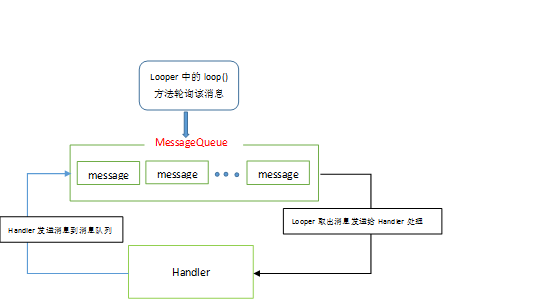一、简介
消息处理机制主要涉及到这几个类:
1.Looper
2.MessageQueue
3.Message
4.Handler

二、源码分析
Looper.class的关键源码:
//保存Looper对象,在android中每创建一个消息队列,就有一个并且是唯一一个与之对应的Looper对象 static final ThreadLocal<Looper> sThreadLocal = new ThreadLocal<Looper>(); //主线程的Looper private static Looper sMainLooper; //消息队列 final MessageQueue mQueue; final Thread mThread; //子线程中通过调用该方法来创建消息队列 public static void prepare() { prepare(true); } private static void prepare(boolean quitAllowed) { if (sThreadLocal.get() != null) { throw new RuntimeException("Only one Looper may be created per thread"); } sThreadLocal.set(new Looper(quitAllowed)); } //主线程调用该方法来创建消息队列 public static void prepareMainLooper() { prepare(false); synchronized (Looper.class) { if (sMainLooper != null) { throw new IllegalStateException("The main Looper has already been prepared."); } sMainLooper = myLooper(); } } //实例化Looper,创建消息队列,获取当前线程 private Looper(boolean quitAllowed) { mQueue = new MessageQueue(quitAllowed); mThread = Thread.currentThread(); } //调用loop方法开启消息循环 public static void loop() { //获取当前的Looper对象,若为null,抛出异常 final Looper me = myLooper(); if (me == null) { throw new RuntimeException("No Looper; Looper.prepare() wasn't called on this thread."); } //获取当前的消息队列,进入循环 final MessageQueue queue = me.mQueue; for (;;) { //调用next()方法从消息队列中获取消息,如果为null,结束循环;否则,继续执行(有可能会阻塞) Message msg = queue.next(); if (msg == null) { return; } ...... try { //调用handler的dispatchMessage(msg)分发消息 msg.target.dispatchMessage(msg); } finally { ...... } //回收消息资源 msg.recycleUnchecked(); } } //消息循环退出 public void quit() { mQueue.quit(false); } public void quitSafely() { mQueue.quit(true); }
消息循环退出过程
从上面可以看到loop()方法是一个死循环,只有当MessageQueue的next()方法返回null时才会结束循环。那么MessageQueue的next()方法何时为null呢?
在Looper类中我们看到了两个结束的方法quit()和quitSalely()。
两者的区别就是quit()方法直接结束循环,处理掉MessageQueue中所有的消息。
quitSafely()在处理完消息队列中的剩余的非延时消息(延时消息(延迟发送的消息)直接回收)时才退出。这两个方法都调用了MessageQueue的quit()方法
MessageQueue.class 的关键源码:
MessageQueue中最重要的就是两个方法:
1.enqueueMessage()向队列中插入消息
2.next() 从队列中取出消息
/* *MessageQueue中enqueueMessage方法的目的有两个: *1.插入消息到消息队列 *2.唤醒Looper中等待的线程(如果是即时消息并且线程是阻塞状态) */ boolean enqueueMessage(Message msg, long when) { //发送该消息的handler为null,抛出异常 if (msg.target == null) { throw new IllegalArgumentException("Message must have a target."); } //此消息正在被使用 if (msg.isInUse()) { throw new IllegalStateException(msg + " This message is already in use."); } synchronized (this) { //此消息队列已经被放弃了 if (mQuitting) { IllegalStateException e = new IllegalStateException( msg.target + " sending message to a Handler on a dead thread"); msg.recycle(); return false; } msg.markInUse(); msg.when = when; //消息队列的第一个元素,MessageQueue中的成员变量mMessages指向的就是该链表的头部元素。 Message p = mMessages; boolean needWake; if (p == null || when == 0 || when < p.when) { //如果此队列中头部元素是null(空的队列,一般是第一次),或者此消息不是延时的消息,则此消息需要被立即处理, //将该消息作为新的头部,并将此消息的next指向旧的头部。如果是阻塞状态则需要唤醒。 msg.next = p; mMessages = msg; needWake = mBlocked; } else { //如果此消息是延时的消息,则将其添加到队列中, //原理就是链表的添加新元素,按照时间顺序来插入的,这样就得到一条有序的延时消息链表 needWake = mBlocked && p.target == null && msg.isAsynchronous(); Message prev; for (;;) { prev = p; p = p.next; if (p == null || when < p.when) { break; } if (needWake && p.isAsynchronous()) { needWake = false; } } msg.next = p; prev.next = msg; } if (needWake) { nativeWake(mPtr); } } return true; } Message next() { //与native方法相关,当mPtr为0时返回null,退出消息循环 final long ptr = mPtr; if (ptr == 0) { return null; } int pendingIdleHandlerCount = -1; //0不进入睡眠,-1进入睡眠 int nextPollTimeoutMillis = 0; for (;;) { if (nextPollTimeoutMillis != 0) { //处理当前线程中待处理的Binder进程间通信请求 Binder.flushPendingCommands(); } //native方法,nextPollTimeoutMillis为-1时进入睡眠状态 //阻塞方法,主要是通过native层的epoll监听文件描述符的写入事件来实现的。 //如果nextPollTimeoutMillis=-1,一直阻塞不会超时。 //如果nextPollTimeoutMillis=0,不会阻塞,立即返回。 //如果nextPollTimeoutMillis>0,最长阻塞nextPollTimeoutMillis毫秒(超时),如果期间有程序唤醒会立即返回 nativePollOnce(ptr, nextPollTimeoutMillis); synchronized (this) { final long now = SystemClock.uptimeMillis(); Message prevMsg = null; Message msg = mMessages; if (msg != null && msg.target == null) { do { prevMsg = msg; msg = msg.next; } while (msg != null && !msg.isAsynchronous()); } if (msg != null) { if (now < msg.when) { // Next message is not ready. Set a timeout to wake up when it is ready. nextPollTimeoutMillis = (int) Math.min(msg.when - now, Integer.MAX_VALUE); } else { //正常取出消息,设置mBlocked = false代表目前没有阻塞 mBlocked = false; if (prevMsg != null) { prevMsg.next = msg.next; } else { mMessages = msg.next; } msg.next = null; msg.markInUse(); return msg; } } else { // No more messages.更新到睡眠状态 nextPollTimeoutMillis = -1; } // Process the quit message now that all pending messages have been handled. if (mQuitting) { dispose(); return null; } // If first time idle, then get the number of idlers to run. // Idle handles only run if the queue is empty or if the first message // in the queue (possibly a barrier) is due to be handled in the future. if (pendingIdleHandlerCount < 0 && (mMessages == null || now < mMessages.when)) { pendingIdleHandlerCount = mIdleHandlers.size(); } if (pendingIdleHandlerCount <= 0) { // No idle handlers to run. Loop and wait some more. mBlocked = true; continue; } if (mPendingIdleHandlers == null) { mPendingIdleHandlers = new IdleHandler[Math.max(pendingIdleHandlerCount, 4)]; } mPendingIdleHandlers = mIdleHandlers.toArray(mPendingIdleHandlers); } } //非睡眠状态下处理IdleHandler接口 for (int i = 0; i < pendingIdleHandlerCount; i++) { final IdleHandler idler = mPendingIdleHandlers[i]; // release the reference to the handler mPendingIdleHandlers[i] = null; boolean keep = false; try { keep = idler.queueIdle(); } catch (Throwable t) { Log.wtf(TAG, "IdleHandler threw exception", t); } if (!keep) { synchronized (this) { mIdleHandlers.remove(idler); } } } pendingIdleHandlerCount = 0; nextPollTimeoutMillis = 0; } }
Handler.class源码分析:
/* *通过handler类向线程的消息队列发送消息, *每个Handler对象中都有一个Looper对象和MessageQueue对象 */ public Handler(Callback callback, boolean async) { if (FIND_POTENTIAL_LEAKS) { final Class<? extends Handler> klass = getClass(); if ((klass.isAnonymousClass() || klass.isMemberClass() || klass.isLocalClass()) && (klass.getModifiers() & Modifier.STATIC) == 0) { Log.w(TAG, "The following Handler class should be static or leaks might occur: " + klass.getCanonicalName()); } } //获取Looper对象 mLooper = Looper.myLooper(); if (mLooper == null) {...} //获取消息队列 mQueue = mLooper.mQueue; mCallback = callback; mAsynchronous = async; } /* *多种sendMessage方法,最终都调用了同一个方法sendMessageAtTime() */ public boolean sendMessageAtTime(Message msg, long uptimeMillis) { MessageQueue queue = mQueue; if (queue == null) { RuntimeException e = new RuntimeException( this + " sendMessageAtTime() called with no mQueue"); Log.w("Looper", e.getMessage(), e); return false; } //向消息队列中添加消息 return enqueueMessage(queue, msg, uptimeMillis); } /* *1.当Message中的callback不为null时,执行Message中的callback中的方法。这个callback时一个Runnable接口。 *2.当Handler中的Callback接口不为null时,执行Callback接口中的方法。 *3.直接执行Handler中的handleMessage()方法。 */ public void dispatchMessage(Message msg) { // 消息Callback接口不为null,执行Callback接口 if (msg.callback != null) { handleCallback(msg); } else { if (mCallback != null) { //Handler Callback接口不为null,执行接口方法 if (mCallback.handleMessage(msg)) { return; } } //处理消息 handleMessage(msg); } }